
|
North-south from US Hwy 50 near Gunnison to US Hwy 160 at South Fork
|
|
Other articles:
• U. S. Highway 50:
at CO 149;
|
Junction: US Highway 50, west to Montrose, or east to Gunnison.
|
|
|
Powderhorn
Junction: County Road 27 “Cebolla Creek Road”
|
|
Other articles:
• Field Notes:
18 Sep 2017;
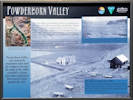 Interpretive panel for Powderhorn Valley. Interpretive panel for Powderhorn Valley.
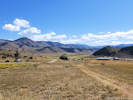 View southwest to the populated place of Powderhorn View southwest to the populated place of Powderhorn
|
Junction: County Road 28, to the Powderhorn Post Office.
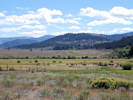
Horses grazing in Powderhorn Valley |
|
Powderhorn Valley
Powderhorn Valley was named by mountain men and fur trappers because the shape of the valley resembles a bison horn that would have been used to keep gunpowder dry.
The Post Office in Powderhorn Valley was established in 1876 when the valley was settled by ranch families looking for lush grassland to support cattle. In the early years, Powderhorn Valley supplied beef and potatoes that fed the hungry miners and most of the hay for the horses, mules, and burros that worked in the mines in the mountains above Lake City.
For years, families shopped at Youman's store. Everything in the store was behind the counter and customers had to ask for needed items. Household goods, including fabric, nails, flour, and seed were available only in bulk and needed to tbe measured or weighed at the time goods were sold.
|
|
|
Other articles:
• Field Notes:
18 Sep 2017;
Locations:
Gateview.
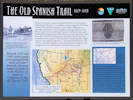 Interpretive panel for the Old Spanish Trail Interpretive panel for the Old Spanish Trail
|
Gateview
Junction: County Road 25 “Blue Mesa Cutoff Road”
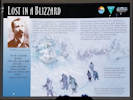
Interpretive panel “Lost in a Blizzard” |
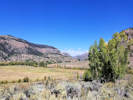
Looking downstream on the Lake Fork of the Gunnison River |
|
The Old Spanish Trail 1829-1848
Between 1829 and 1848 woolen goods were transported by mule caravans from the Mexican outpost of Santa Fe to the Missions of Southern California on the Old Spanish Trail.
Annual mule pack caravans traveled the historic Old Spanish Trail between Santa Fe, New Mexico and Los Angeles, California. Traders from Santa Fe headed to San Gabriel Mission as a welcome destination. They brought woolen goods from New Mexico and returned with highly prized California mules and horses. Following ancient Native American trails, the trade route went into central Utah during Spanish Colonial days and continued as an emigrant trail during the Mexican period. Anglo trappers and military expeditions, including John Fremont, Kit Carson, and John Gunnison used various routes of what is now recognized as the Old Spanish National Historic Trail.
In June 1853, Lieutenant Edward Beale, accompanied by Gwinn Harris Heap detailed their travel route through this area. Head wrote “ … we crossed the two forks of the Jaroso (Cebolla Creek and Powderhorn Creek) … we rested for the night by a small shallow brook, very marshy, and swarming with mosquitos … Numbers of deer and antelopes were seen; indeed, these sheltered calleys seem expressly intended as coverts for those gentle animals … Traders from Abiquiu come by it into these mountains to barter for peltries with the Utahs (Ute Indians).”
|
|
Lost in a Blizzard
“In the Colorado Rockies where the snow is deep and cold … a man afoot can starve to death unless he's brave and bold.” -- Ballad of Alferd Packer
What is now recognized as one of the most notorious events in Colorado's history -- cannibalism by Alferd Packer -- unfolded in the valley below you. If was here that Alferd Packer and his men made a most disastrous mistake, then missed a turn in the trail and became hopelessly lost in the San Juan Mountains.
On that fateful day in February 1874, Alferd Packer became lost in a severe snow storm while guiding five men from Salt Lake City ti the Los Piños Indian Agency, located south of what is now Gunnison. At the time, the Old Spanish Trail was a well worn trail that continued on to Taos and Santa Fe. Unfortunately, snow covered the trail in the valley below and the hapless men continued to the south instead of remaining in the trail to the east.
Cannibalism in the high country could have been averted had they remained on the correct trail towards Cohetopa Pass.
|
|
|
Other articles:
• Field Notes:
18 Sep 2017;
Locations:
The Gate.
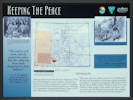 Interpretive panel at The Gate Interpretive panel at The Gate
|
The Gate
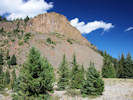
The walls of The Gate |
|
Keeping the Peace
“The trail is well worn, and the peeled trees show that the valley has been much frequented by (Ute) Indians.”
Gold was discovered in the San Juan Mountains in the late 1860s leading to a rush of miners. Tension rose between the miners seeking gold and the Ute Indians who lived and hunted in the mountains. As a result, the U. S. Government negotiated the Brunot Treaty in 1873 with Chief Ouray and the Weminuche Ute.
“At this point we passed the Great Gate, a rift in a spar sweeping around from range to range across the calley.” -- Lt. E. H. Ruffner, Corps of Engineers, Reconnaissance in the Ute Country, 1873
That same year, the military sent Lt. E. H. Ruffner into the San Juan Mountains to document mining operations in Southern Colorado and evaluate the effectiveness of the Brunot Treaty. Ruffner noted, “While at Camp 47 we were visited by many western Utes, mostly well armed, well mounted, and well dressed; uncommonly clean, smiling and civil; short men, with broad muscular shoulders.”
|
|
|
|
Junction: Forest Road 868 “Alpine Plateau Road”
|
|
|
Gunnison County above …
Hinsdale County below …
|
|
Literature Cited:
- Pitblado, Bonnie L., 2015.
Other articles:
• Field Notes:
18 Sep 2017;
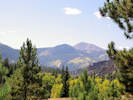 Hazy view of turning aspens Hazy view of turning aspens
|

Interpretive panel for Early Holocene Encampment |
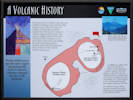
Interpretive panel for Lake City Caldera |
|
A Volcanic History
Twenty million years ago this entire region was geologically active as massive volcanoes changed the face of the landscape.
If you were here 23 million years ago, you would be standing on the northern edge of that is now called the Lake City Caldera. As the magma chamber emptied from this massive volcano it could no longer hold its shape. The volcano collapsed and fell into itself. This formed the landscape we see today. Most of the rocks surrounding the caldera including granite, obsidian, basalt, tuff and pumice are direct evidence of this region's violent volcanic past.
A caldera is a caldron-like feature formed by the collapse of land following a volcanic eruption. With the collapse of the Lake City and Silverton calderas, a volcanic soup of minerals was injected into the surrounding rock. This produced a rich intrusion of silver, gold, lead, copper, tellurium, and iron. For millions of years, these deposits remained untouched until discovered by prospectors in the 1860s and 1870s.
|
|
Early Holocene Encampment
Nearly 10,000 years ago, archaic hunters and gatherers camped along the Lake Fork of the Gunnison River. Here they hunted wild game such as bighorn sheep and elk in these alpine valleys.
At the end of the last Ice Age, Archaic big game hunters skillfully hunted animals such as elk, deer, bighorn sheep, and a now extinct variety of bison (Bison taylori). Archaeological evidence indicates that these hunters camped along the Lake Fork of the Gunnison River. Stone tools found in these emcampments include bifaces, drills, scrapers, projectile points, and point fragments.
Near the end of the Ice Age, during a colder and wetter period of time, Archaic hunters lived in small bands. Indications are that they did not stay in any one place very long, but moved often in search of game animals.
|
|
|
Other articles:
• Field Notes:
18 Sep 2017;
Locations:
Lake City.
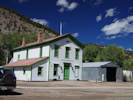 Hinsdale County Court House Hinsdale County Court House
|
Lake City
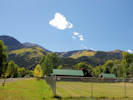
Turning aspens above Lake City |
|
|
Literature Cited:
- Anonymous, 2015.
Other articles:
• Field Notes:
18 Sep 2017;
Locations:
Alferd Packer Massacre Site.
|
Alferd Packer Massacre Site
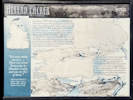
Interpretive panel at Alferd Packer massacre site. |
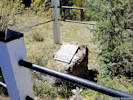
Plaque at Alferd Packer massacre site. |
|
Alferd Packer
“You man eating son of a … There was seven Democrats in Hinsdale County and you ate five of them.”
-- Quote attributed to saloon keeper Larry Dolan after Alferd Packer's first trial.
In February 1874, Alferd Packer became lost in a severe snow storm while guiding five men from Salt Lake City to the Los Piños Agency , (south of Gunnison).
In mid-April, Packer arrived at the Los Piños Agency -- alone. Upon interrogation, he claimed that as each person died the other men ate the flesh of the dead. Packer said he killed only one person, but only in self-defense. That summer, five bodies were discovered at this site. Each person's head had been crushed. Alferd Packer was arrested and accused of murder and cannabalism. Before his trial, however, he fled Colorado.
Nine years later, Packer was captured in Wyoming and was returned to Colorado. He was found guilty of manslaughter and sentenced to prison for forty years. After serving fifteen years he was paroled in 1901. Until his death in 1907, Packer maintained his innocence in one of the most notorious events in Colorado's history.
|
|
|
|
Road crosses the Slumgullion Earthflow.
There is a small parking lot here. The currently active toe of the youngest earthflow should be accessible by walking about 150 m. up the flow.
|
|
Other articles:
• Field Notes:
18 Sep 2017;
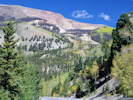 Slumgullion Earthflow from Lake San Cristobal Overlook Slumgullion Earthflow from Lake San Cristobal Overlook
 Lower end of Lake San Cristobal Lower end of Lake San Cristobal
|
Lake San Cristobal Overlook.
This is also the best place to view the Slumgullion Earthflow. Walk back around the hairpin turn for the view.
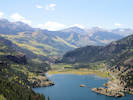
Upper end of Lake San Cristobal |
|
|
Literature Cited:
- Varnes, D. J., and W. Z. Savage, eds.,, 1996.
Other articles:
• Field Notes:
18 Sep 2017;
Locations:
Slumgullion Earthflow.
|
Slumgullion Earthflow Overlook
Poor view of Slumgullion Earthflow, needs viewshed management.
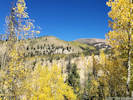
View of Slumgullion from the official viewpoint |

Interpretive panel for Slumgullion Earthflow |
|
Slumgullion Earthflow
The Slumgullion Earthflow was listed on the Natural Registry of Natural Landmarks in 1965 and designated a Colorado Natural Area in 1983.
Imagine what it must have looked like as a massive block of rock, dirt, and forest broke away from Mesa Seco and an enormous earthflow oozed into the valley below. About 850 years ago, during a very wet period of time, a series of slow-moving landslides occurred. the largest landslide dropped over 3,000 feet in elevation and extended downhill more than four miles. What is now called the Slumgullion Earth flow altered the landscape on over 1,000 acres and created Lake San Cristobal.
The story, however, is not over. About 350 years ago, the most recent earthflow began to descend. This flow covered half of the older flows and is still active today. Geologists estimate that in places it is still moving downhill about twenty feet per year.
Slumgullion is a mining word used to describe the muddy clay left in the bottom of a sluice box. However, miners often cooked a hearty and colorful stew that resembles the color of the Slumgullion Earthflow.
Slumgullion Stew
1½ lb. stew meat
1 sliced onion
1 bunch carrots
3 red potatoes
1 bell pepper
1 can black-eyed peas
4-6 cups water
Add leftover cabbage, corn, green beans, etc.
Add salt, pepper, and thyme to taste.
Thicken broth with flour.
Add ½ cup of macaroni in the last ½ hour of cooking.
|
|
|
Other articles:
• Field Notes:
18 Sep 2017;
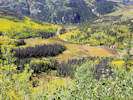 Meadow below Windy Point Overlook Meadow below Windy Point Overlook
|
Meadow
|
|
Other articles:
• Field Notes:
18 Sep 2017;
Locations:
Windy Point Overlook.
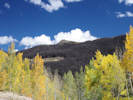 Beetle-killed trees on Slumgullion Summit Beetle-killed trees on Slumgullion Summit
|
Windy Point Overlook
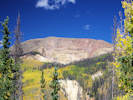
Head scarp of the Smulgullion Earthflow |

Interpretive panel at Windy Point Overlook |
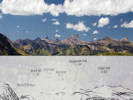
Uncompahgre Peak in the San Juan Mountains |
|
I Felt the Earth Move
A massive portion of Mesa Seco gave way about 850 Years ago. This resulted in the Slumgullion Earthflow, one of the most visible examples of “mass wasting” in the United States.
About 850 years ago, thousands of tons of water-saturated, earthen material broke away from Mesa Seco and slid nearly four miles into the valley below. The Slumgullion Earthflow dammed the Lake Fork of the Gunnison River and formed Lake San Cristobal -- the second largest natural lake in Colorado.
About 350 years ago, another portion of Mesa Seco began to slowly ooze down the hillside. Riding above the older slide, this flow covered about 2.5 miles of the older flow. Geologists estimate that it is still moving downhill approximately twenty feet per year.
|
|
|
|
Junction: County Road 50, Forest Road 788 “Cebolla Road”
|
|
Other articles:
• Field Notes:
18 Sep 2017;
Locations:
Slumgullion Pass.
 Slumgullion Summit Slumgullion Summit
|
Slumgullion Pass, 11,361 ft.
Slumgullion Pass forms the divide between Slumgullion Creek and Mill Creek, both of which are tributary to the Gunnison River.
|
|
Other articles:
• Field Notes:
18 Sep 2017;
Locations:
Spring Creek Pass.
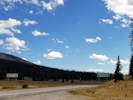 Spring Creek Pass, Continental Divide, 10,898 ft. Spring Creek Pass, Continental Divide, 10,898 ft.
|
Gunnison (Colorado) River basin above …
Spring Creek Pass, 10, 901 ft. Continental Divide.
Rio Grande River basin below …
|
|
|
Hinsdale County above …
Mineral County below …
|
|
Literature Cited:
- Lipman, Peter W., 2006.
Other articles:
• Field Notes:
18 Sep 2017;
Locations:
North Clear Creek Falls.
|
Junction: Forest Road 510, to North Clear Creek Falls Observation Site.
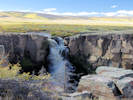
North Clear Creek Falls |
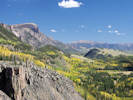
View southwest from North Clear Creek Falls |
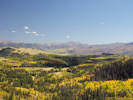
Clear Creek Graben |
|
|
Other articles:
• Forest Road 520:
at CO 149;
• Field Notes:
18 Sep 2017;
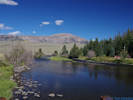 The Rio Grande River exits from the San Juan Mountains The Rio Grande River exits from the San Juan Mountains
|
Junction: County Road 18, Forest Road 520 “Rio Grande Reservoir Road”
|
|
Locations:
Antelope Park.
|
Antelope Park
Colorado Highway 149 turns 90° to northeast in the direction of Creede.
|
|
|
Enter the Creede caldera.
|
|
Literature Cited:
- Axelrod, Daniel I., 1987.
|
Junction: Airport Road
At this location numerous plant fossils, mineral impressions and occasional insect fossils may be found
on the hill to the north side of the road by parting the thin layered rock.
After the formation of the Creede Caldera, a salty lake formed in the crater,
which received palnt debris and sediment as they eroded down from the surround hills.
This sediment eventually turned into rock that is mostly composed of very fine grained volcanic ash.
(https://www.creede.com/recreation-activities/explore/geology, date accessed 28 December 2022.)
|
|
Literature Cited:
- Larsen, Esper S., 1929.
Other articles:
• Field Notes:
19 Sep 2017;
Locations:
Creede.
|
Creede
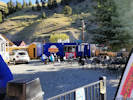
The Mac Mine, the only restaurant open for business on an off-season Tuesday morning |
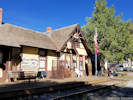
The former D&RGW depot, now the history museum |
|
|
Other articles:
• Field Notes:
20 Sep 2017;
Locations:
Wagon Wheel Gap.
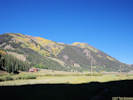 Looking upstream from Wagon Wheel Gap Looking upstream from Wagon Wheel Gap
|
Wagon Wheel Gap
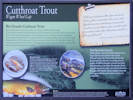
Interpretive panel for Rio Grande Cutthroat Trout at Wagon Wheel Gap |
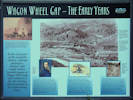
Interpretive panel at Wagon Wheel Gap |
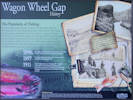
Interpretive panel at Wagon Wheel Gap |
|
Wagon Wheel Gap -- The Early Years
In the early part of the twentieth century, railroad passengers, tourists, and health seekers boarded wagons at Wagon Wheel Gap and ventured to the Hot Springs Hotel to partake in the rejuvenating water.
The Denver and Rio Grande Railroad touted the healing qualities of the hot springs located near Wagon Wheel Gap. These springs soom became a destination for health seekers.
In December, 1848, John Fremont led an expedition into the San Juan Mountains to find a route for the transcontinental railroad. The ill-fated expedition may have traveled up Embargo Creek, (to the east of Wagon Wheel Gap), where they encountered a vicious winter storm. With ten feet of snow and deteriorating conditions, Fremont abandoned his expedition and each man fended for himself. All told, ten of Fremonts men died of cold or starvation in the San Juan Mountains.
In 1863, Charles Baker led a group of prospectors into the San Juan Mountains. While returning to New Mexico for the winter, then abandoned a damaged wagon near the “gap” where the Rio Grande carved a small canyon. In the 1870s, a wagon wheel was discovered in this area and it was believed to be a remnant from the Baker party. Miners referred to this area as “the gap where the wagon wheel was found.” Over time this area became known as Wagon Wheel Gap.
Wheeler Geologic Area was named in honor of George M. Wheeler, who surveyed much of Colorado in 1874. The area was designated a National Monument in 1908 by President Theodore Roosevelt in part to protect the highly erodible spires, hoodoos, and geologic formations. Due to its isolated location and diffifult access, the area was delisted as a National Monument in 1933. Wheeler Geologic Monument is now managed by the Rio Grande National Forest.
|
|
|
|
Exit Creede caldera.
|
|
|
Junction: Goose Creek Road
|
|
|
Goose Creek enters the Rio Grande River from the south.
|
|
|
Cottonwood Cove Guest Ranch
|
|
|
Blue Creek Lodge and historical Wagon Wheel Gap Post Office
|
|
|
Mineral County above …
Rio Grande County below …
|
|
Other articles:
• Field Notes:
20 Sep 2017;
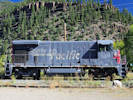 Ex-Southern Pacific GE B30-7 7863 in South Fork, CO Ex-Southern Pacific GE B30-7 7863 in South Fork, CO
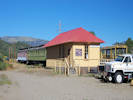 South Fork depot South Fork depot
|
Railroad depot and storage yard on the west end of South Fork.
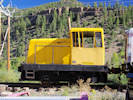
Locomotive No. 1 |
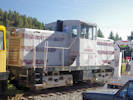
Ex-Utah Central GE 44-ton locomotive |

Denver and Rio Grande, something, not quite a goose, maybe a mudhen. |
|
|
Other articles:
• US Highway 160:
South Fork;
Locations:
South Fork.
|
South Fork
Junction: US Highway 160, west to Pagosa Springs, or east to Alamosa.
|
|
If you have a question or a comment you may write to me at:
tomas@schweich.com
I sometimes post interesting questions in my FAQ, but I never disclose your full name or address.
|
[Home Page] [Site Map]
Date and time this article was prepared:
5/12/2025 2:49:24 PM
|
 Eastern Mojave Vegetation
Eastern Mojave Vegetation
 Eastern Mojave Vegetation
Eastern Mojave Vegetation
